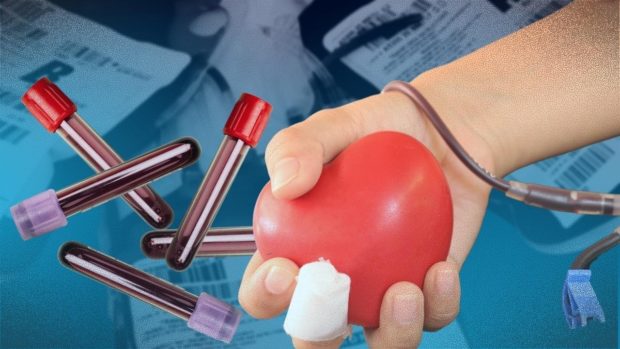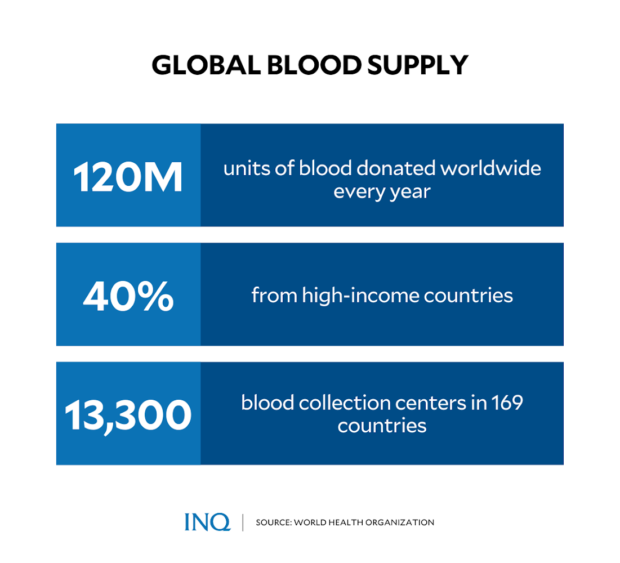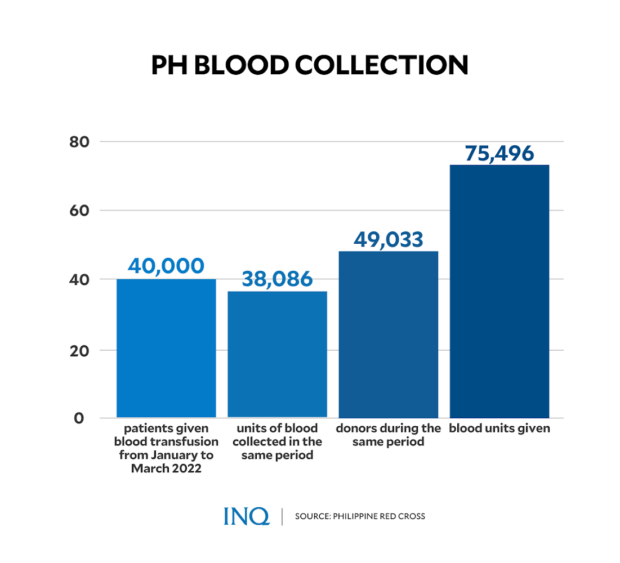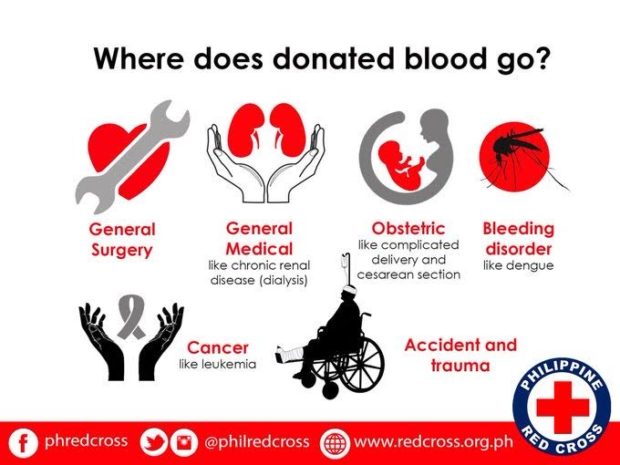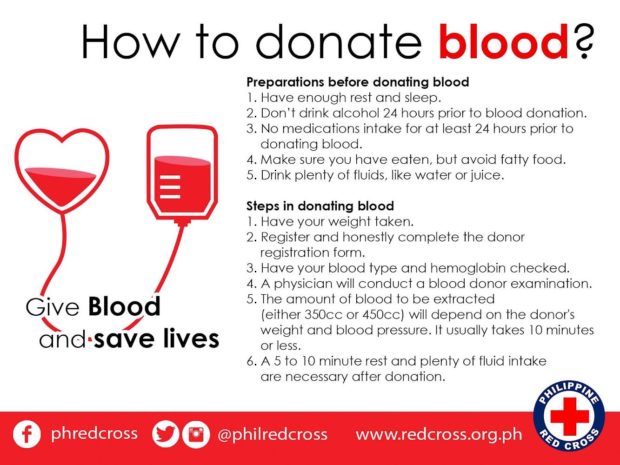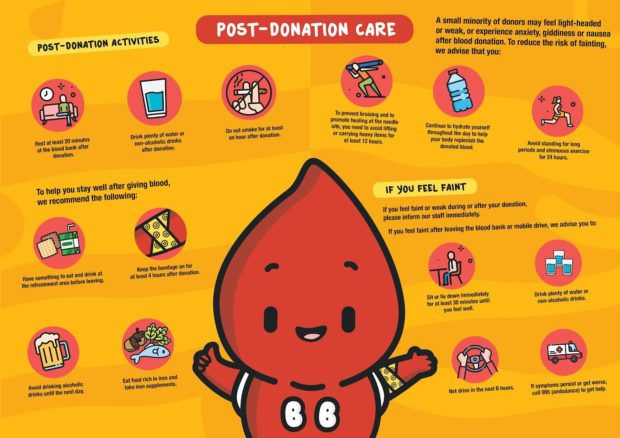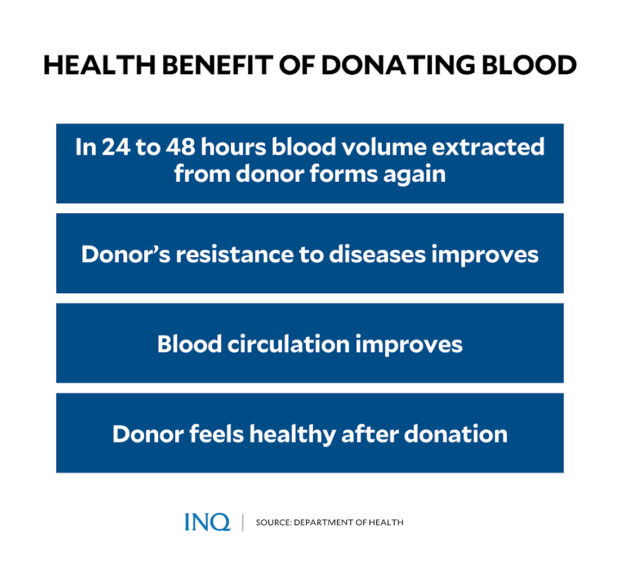PH Blood Donors Month: FAQs, myths on giving blood
MANILA, Philippines—Every July, Filipinos are encouraged to donate blood as the country observes National Blood Donors Month.
July was declared Blood Donors Month by Proclamation No. 1021 signed on June 9, 1977, by then-President Fidel V. Ramos.
“[T]he Code of Ethics for Blood Donation and Transfusion provides that blood donation shall, in all circumstances, be voluntary,” the proclamation stated.
“[B]lood donation is a humanitarian act that has saved thousands of human lives. [A]ssurance of adequate supply of volunteer-sourced human blood depends on a sustained promotion of the advantages of voluntary blood donation,” it added.
According to the World Health Organization (WHO), blood transfusion saves lives and improves health. However, many patients requiring transfusion do not have timely access to safe blood.
“Blood transfusions are needed for a wide range of health conditions including anemia, complications during pregnancy and childbirth, severe trauma due to accidents, and surgical procedures. They are also regularly used for patients with conditions such as sickle cell disease and thalassemia and for products to treat hemophilia,” said WHO.
READ: EXPLAINER: Five things you need to know about hemophilia
READ: Six years later, Filipinos with hemophilia still struggle in getting treatment
“Providing safe and adequate blood should be an integral part of every country’s national health care policy and infrastructure,” it added.
In this article, in observation of Blood Donors Month, INQUIRER.net will explain more details about voluntary blood donation in the country, why Filipinos should try to donate blood, and present other frequently asked questions and myths about donating blood.
Million units of blood donated every year
According to statistics by WHO, nearly 120 million units of blood are donated worldwide every year. Around 40 percent of these are collected in high-income countries.
There are at least 13,300 blood centers located in 169 countries that report collecting a total of 106 million units of blood donations yearly.
Of those total blood donations, the median annual donations per blood center are 1,300 in low-income countries, 4,400 in lower-middle-income countries, 9,300 in upper-middle-income countries, and 25,700 in high-income countries.
However, this remains insufficient to meet the global need. Many patients requiring a transfusion, unfortunately, do not have timely access to safe blood.
“The unavailability of timely, safe blood transfusions has led to many otherwise avoidable deaths. A consistent supply of blood is a cornerstone of any healthcare system, but this relies on regular donations and effective healthcare infrastructure,” WHO said.
“Compounding insufficient collection rates is the inability of many health care systems to adequately screen donated blood for diseases such as HIV, hepatitis B, hepatitis C, and syphilis according to quality system requirements,” WHO added.
The WHO attributed the inability to test blood to the irregular supply of testing kits particularly in low-income areas. The lack of testing contributes to the spread of transfusion-transmissible infections, which can compromise the patient’s well being and further strain health care systems.
Another issue stressed by WHO was that blood can not be stored indefinitely, meaning there is a constant need for donations.
“Maintaining safe and effective procedures around the collection, storage and use of donated blood is essential. Collectively called hemovigilance, these procedures cover the entire blood transfusion chain and are used to standardize the use of blood in health care,” said WHO.
Aside from blood transfusions, donated blood can also be processed and converted into plasma, red cell concentrates, platelet concentrates, and more—all of which can be used for specific cases in health care delivery.
“In some cases, this allows a unit of donated blood to meet the needs of more than one patient and is an important aspect of the transfusion train. However, not all countries have facilities to process blood in this way, and only 50 of 173 reporting countries produce plasma-derived medicinal products domestically.”
Blood supply shortage in PH
In 2020, amid the pandemic, the rise in novel coronavirus disease (COVID-19) cases has led to the cancellation of several bloodletting events as many donors decided to back out or decline due to fear of contracting SARS-CoV-2, the virus that causes COVID-19.
READ: COVID-19 threat, Luzon lockdown scare off blood donors
In April of that same year, then-President Rodrigo Duterte encouraged COVID-19 survivors to make blood donations, which can be helped to study the virus.
Prior to Duterte’s call for blood donations, the Philippine General Hospital (PGH) explained that the blood of convalescent or recovered patients, specifically its plasma, contains antibodies that will help fight SARS-CoV-2, the virus that causes the respiratory illness.
READ: Duterte asks recovered COVID-19 patients to donate blood
Two months later, Richard Gordon—chairman and CEO of the Philippine Red Cross (PRC)—renewed his call for blood donations due to the increased risk of shortage of blood supply in the country.
READ: Gordon renews call for blood donors to avert supply shortage
In July 2020, the Department of Health (DOH) finally announced that the supply of blood in the country was already nearing critical level—still due to the lack of blood donations that was attributed to the COVID-19 pandemic.
READ: Blood supply nearing critical level amid pandemic — DOH
READ: DOH calls for blood donation amid lower output in 2020
Up until 2021, the health department, PRC, health experts, and several lawmakers continued to urge the public to donate blood as they raised alarm over the dwindling supply of blood needed for vital medical procedures.
In September last year, Gordon said that “the demand for blood [donations] never stopped,” encouraging COVID-19 vaccinees to donate blood.
This year, the PRC said that from January 1 to March 21, 2022 alone, the PRC National Blood Services has served over 40,000 patients. During the same period, it collected 36,086 units from 49,033 donors and dispensed 75,496 blood units.
FAQs, debunking blood donation myths
There are many frequently asked questions on donating blood, as well as myths surrounding the procedure, which the DOH and PRC have answered and clarified in the past. These questions and myths include:
Q: Why should people donate blood?
The simplest answer, according to PRC, is that donated blood can be used to save lives.
“Blood is the most precious gift that anyone can give to another person – the gift of life. A decision to donate your blood can save a life, or even several if your blood is separated into its components – red cells, platelets, and plasma – which can be used individually for patients with specific conditions,” WHO said.
Q: Who can donate blood, and how often?
The criteria for donor selection varies from country to country, WHO said, “but blood can be donated by most people who are healthy and do not have an infection that can be transmitted through their blood.”
According to DOH, the basic requirement of a potential blood donor in the Philippines include:
- Weight: At least 50 kg.
- Blood volume collected will depend mainly on your body weight.
- Pulse rate: Between 60 and 100 beats/minute with a regular rhythm.
- Blood pressure: Between 90 and 160 systolic and 60 and 100 diastolic.
- Hemoglobin: At least 125 g/L.
PRC said a healthy individual who is eligible to give blood may donate every three months.
Q: In which situations do people generally donate blood?
To answer this question, the National Voluntary Blood Services Program (NVBSP) of DOH identified three types of blood donors, which include:
- Professional or paid donors: These donors, according to DOH, sell their blood which is often of very poor quality and “can transmit very dangerous diseases to the recipient.” It is illegal to take blood from any professional or paid donor.
- Replacement donation: This involves healthy individuals who give their blood—of any group—to the blood bank when it is required by a member of their own family or community. In most cases, these donors include healthy relatives or friends of a patient.
- Voluntary donation: Under voluntary donation, donors donate their blood voluntarily. “The blood can be used for any patient even without divulging the identity of the donor. This is the best type of blood donation where a motivated human being gives blood in an act of selfless service.”
Q: What are the reasons a person cannot donate blood?
There are certain conditions that may prevent an individual from donating blood temporarily or permanently, according to DOH. Among the temporary conditions are:
- Pregnancy
- Acute fever
- Recent alcoholic intake
- Ear or body piercing and tattooing
- Surgery
Meanwhile, persons with the following conditions are not allowed to donate blood anytime:
- Cancer
- Cardiac disease
- Severe lung disease
- Hepatitis B and C
- HIV infection, AIDS, or Sexually Transmitted Diseases (STD)
- High-risk occupation (e.g. prostitution)
- Unexplained weight loss of more than 5 kg over 6 months
- Chronic alcoholism
- Other conditions or diseases stated in the Guide to Medical Assessment of Blood Donors.
Q: Where can I donate?
In the Philippines, individuals can donate blood at Blood Service Facilities (BSF), including:
- Philippine Blood Center
- DOH Hospitals (BSF)
- PRC (BSF)
- Local Government Units (LGUs) / Non-Government Organizations (NGOs) (BSF)
People can also donate blood during various mobile blood donation activities hosted by communities, participating government organizations, private Kabalikat agencies, schools, and universities.
Q: Are the health history questions necessary every time people donate?
To ensure the safest possible blood supply, the DOH said all donors must answer all the screening questions at each donation. The health department likewise requires blood centers to conform to this practice.
Q: How much blood will be taken? Will I have enough?
For a whole blood donation, DOH said approximately one pint (which weighs about 0.4 kilogram)—or about 450 to 500 milliliters—is collected.
Meanwhile, for a platelet donation, the amount collected depends on the person’s height, weight, and platelet count if collected through apheresis or “about 50 to 70 milliliters for random donor platelet concentrate.”
Myth: People can get AIDS, other diseases by donating blood.
Both the DOH and PRC clarified that there is no risk of contracting AIDS or any other disease through the donation process. It noted that each collection kit used for blood donation is sterile, pre-packaged, and used only once.
Moreover, WHO emphasized that giving blood is safe.
“Remember that you will only be accepted as a blood donor if you are fit and well. Your health and wellbeing are very important to the blood service. The needle and blood bag used to collect blood come in a sterile pack that cannot be reused, so the process is made as safe as possible.”
Myth: Donating blood hurts
“You may feel a slight sting in the beginning, lasting only a couple of seconds, but there should be no discomfort during the donation,” said DOH.
Myth: Donors can suffer from harmful effects after donating blood
Rather than suffering from any harmful effects, DOH said donors often get a feeling of “great pleasure, peace, and bliss” after having given blood.
“Soon, within a period of 24 to 48 hours, the same amount of new blood gets formed in the body, which helps the donor in many ways. His own body resistance improves, the circulation improves, and he himself feels healthier than before.”
Myth: A person who has tattoo or body piercing can not donate blood
The PRC debunked this myth, stating that if the tattooing procedure or the piercing was done a year ago, the person may donate blood.
“This is also applicable to acupuncture, and other procedures involving needles,” PRC added.
